We’ve been trying to Green Up around here. In addition to starting up a composting system for garden waste and kitchen scraps, as well as having plans for an herb and chile garden to use the compost on, we recently went to a mesquite-pod milling event.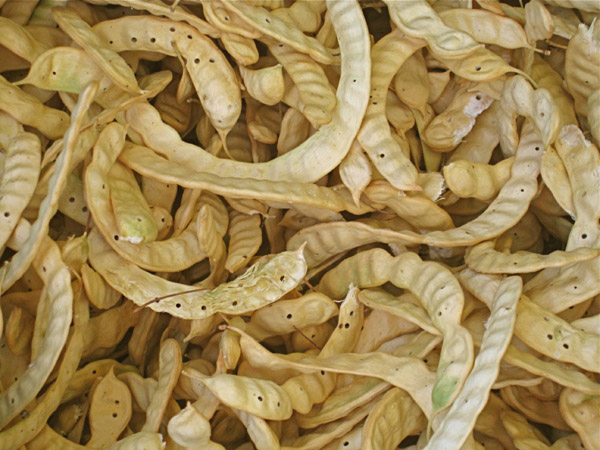
Left: dried mesquite pods
Mesquite pods and seeds are really hard. Really really hard. The seeds especially. So hard that not many animals, even hungry desert mammals with sharp teeth and strong jaws, eat them — despite the seeds’ high protein content. Rock squirrels, coyotes, and gray foxes are among the modern Sonoran species that use the copious pods for a food source. Often, pods are chewed briefly and swallowed whole for the animals’ stomach acid to take care of, and the hard seeds are pooped out later on, germination-enhanced, ready to sprout into fast-growing hardy trees.
Southwestern mesquite tree species evolved at the same time as large Pleistocene grazers like Mastodon and Ground Sloths (below), whose massive grinding molars and powerful 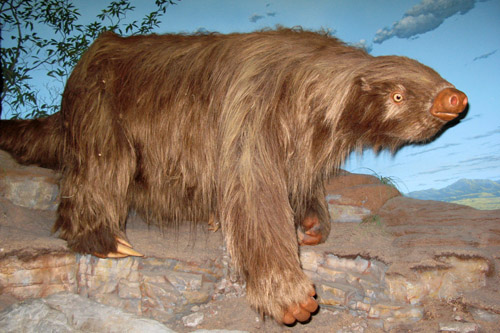 digestive systems propagated the seeds efficiently. The trees’ fast growth habit could keep pace with major inroads of hungry megafauna, and the animals spread the seeds far and wide (cattle have largely replaced these extinct giants in the modern system). People are prodigious users of mesquite, too, for food, furniture, and firewood, and browse for livestock. In some seasons and years, mesquite kept people alive, both indigeños and pioneers. Indigenous people milled the pods for gruel, atole and cakes, but the seeds are almost too hard to grind by hand with a mano and metate, which often were of wood.
digestive systems propagated the seeds efficiently. The trees’ fast growth habit could keep pace with major inroads of hungry megafauna, and the animals spread the seeds far and wide (cattle have largely replaced these extinct giants in the modern system). People are prodigious users of mesquite, too, for food, furniture, and firewood, and browse for livestock. In some seasons and years, mesquite kept people alive, both indigeños and pioneers. Indigenous people milled the pods for gruel, atole and cakes, but the seeds are almost too hard to grind by hand with a mano and metate, which often were of wood.
This is where the Desert Harvesters come in. They are a group dedicated to using food sources native to the Sonoran desert, including mesquite meal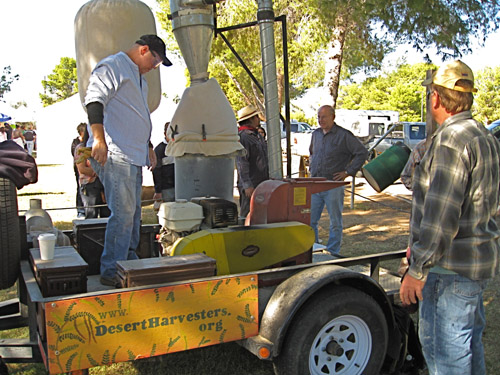 , which is nutritious, naturally sweet but with a low glycemic index, and gluten-free.
, which is nutritious, naturally sweet but with a low glycemic index, and gluten-free.
Right: The Desert Harvesters hammer mill rig
To get mesquite meal, the pods must be ground quite fine, so they use a generator-operated steel hammer mill on a trailer, which they tow to various locations around the state for milling events. The one we attended was sponsored by the Phoenix Permaculture Guild at Roadrunner Park Farmer’s Market. For $5 per 5-gallon bucket, they will grind your clean, dry mesquite pods into fabulously tasty, nutritious meal. We toasted our pods in the oven first, so our meal seems particularly sweet and nutty.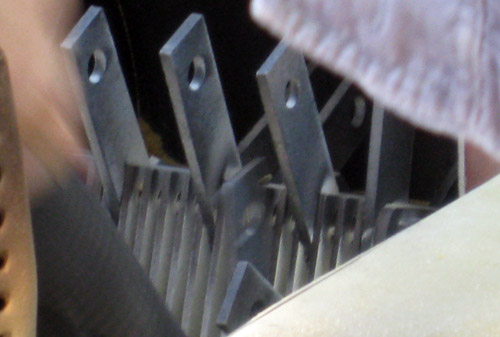
Right: the steel “hammers”
Collecting the pods is easy, but time-consuming. If you’d like to mill your pods, collect whole, dry, brown pods just as they begin to drop from the trees. 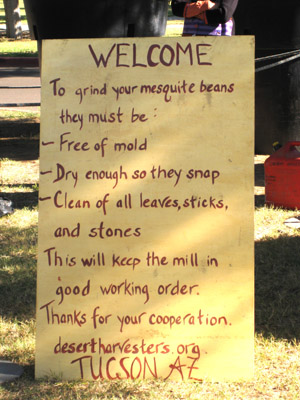 In the Phoenix area, this is roughly mid-summer as the monsoon rains are really beginning to get underway. Dry the pods thoroughly, or toast them in a warm oven until they’re slightly brown. Then store them in an insect-proof bucket until the hammer-milling event is in your neck of the woods, usually the end of October or the beginning of November. (If you live in the Tucson area, you have a few more date options, since Tucson is Desert Harvesters’ home base, but all around the same time of year.)
In the Phoenix area, this is roughly mid-summer as the monsoon rains are really beginning to get underway. Dry the pods thoroughly, or toast them in a warm oven until they’re slightly brown. Then store them in an insect-proof bucket until the hammer-milling event is in your neck of the woods, usually the end of October or the beginning of November. (If you live in the Tucson area, you have a few more date options, since Tucson is Desert Harvesters’ home base, but all around the same time of year.)
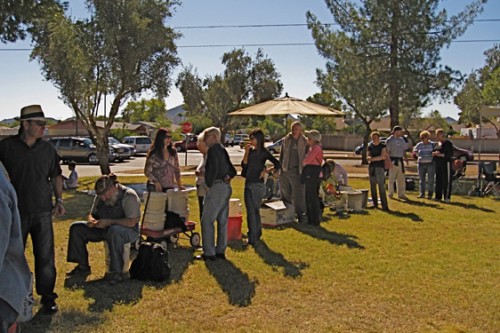 Standing on line waiting for the millers to put your beans in the machine gives you ample time to shop around the Farmer’s Market or talk to other mesquite-bean collectors, and swap mesquite recipes and chat. We talked to Jean, who also had carob pods to grind. The process is not rapid — only a handful of pods goes in at a time, with the mill operators keeping a sharp eye out for rocks and debris, even though everyone’s pods are inspected once already, since hard objects in the steel blades would be hazardous and damaging. The millers often stop to remove the “chaff” from the hammer chamber: even with the powerful steel grinders,
Standing on line waiting for the millers to put your beans in the machine gives you ample time to shop around the Farmer’s Market or talk to other mesquite-bean collectors, and swap mesquite recipes and chat. We talked to Jean, who also had carob pods to grind. The process is not rapid — only a handful of pods goes in at a time, with the mill operators keeping a sharp eye out for rocks and debris, even though everyone’s pods are inspected once already, since hard objects in the steel blades would be hazardous and damaging. The millers often stop to remove the “chaff” from the hammer chamber: even with the powerful steel grinders, 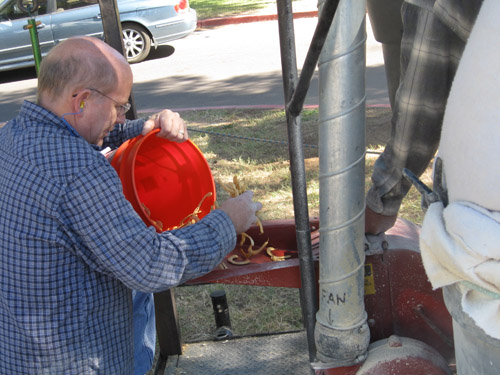 the seeds and tough fiber don’t pulverize, and has to be vacuumed out with a shop-vac every few minutes. The chaff is saved for composting, brewing beer or tea, or feeding goats.
the seeds and tough fiber don’t pulverize, and has to be vacuumed out with a shop-vac every few minutes. The chaff is saved for composting, brewing beer or tea, or feeding goats.
Left, our beans going into the hopper; note dude’s ear-plugs.
The meal-collection bin is emptied after each person’s pods have been ground, so the meal you end up with is from your own pods. We brought two 5-gallon buckets of beans, and ended up with several pounds of meal.
Since there’s no gluten in mesquite meal, it can’t replace wheat flour 1:1 in most recipes, but you can use mesquite meal for up to 1/3 of the total flour amount, including gluten-free recipes. This morning, we enjoyed mesquite pancakes sweetened with agave nectar for breakfast. 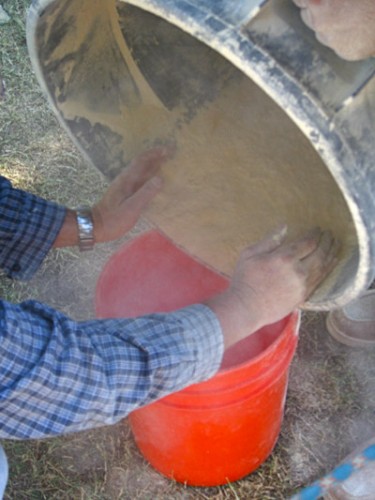 Native Seed Search is an excellent source for info about mesquite meal, or for the meal itself, if you don’t have mesquite trees where you live. But if you do, when you see the price, you’ll definitely want to collect and grind your own.
Native Seed Search is an excellent source for info about mesquite meal, or for the meal itself, if you don’t have mesquite trees where you live. But if you do, when you see the price, you’ll definitely want to collect and grind your own.
Right: our mesquite meal being poured back into our bucket
(All photos A or E Shock)

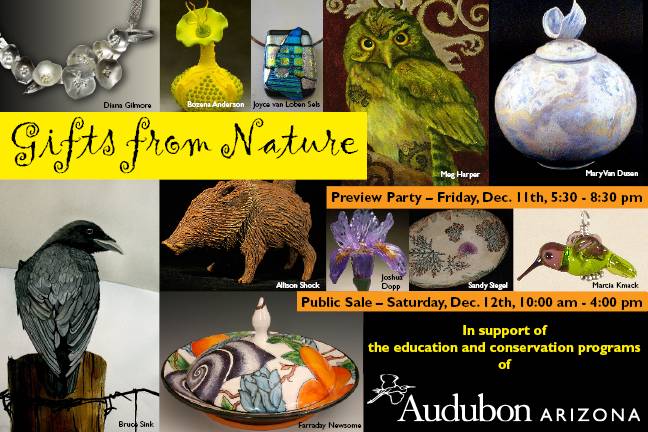
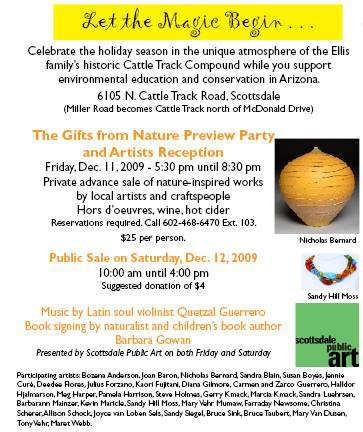
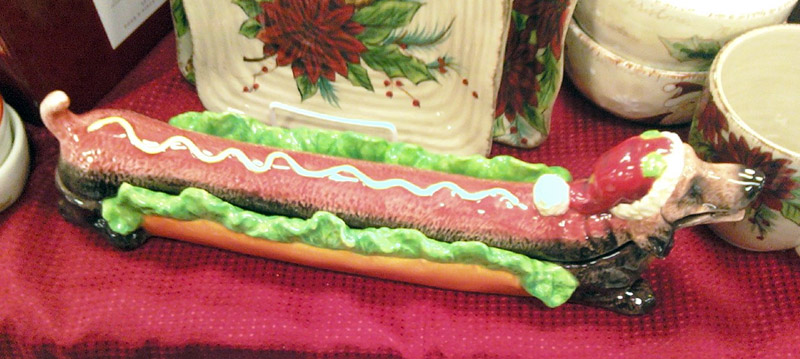

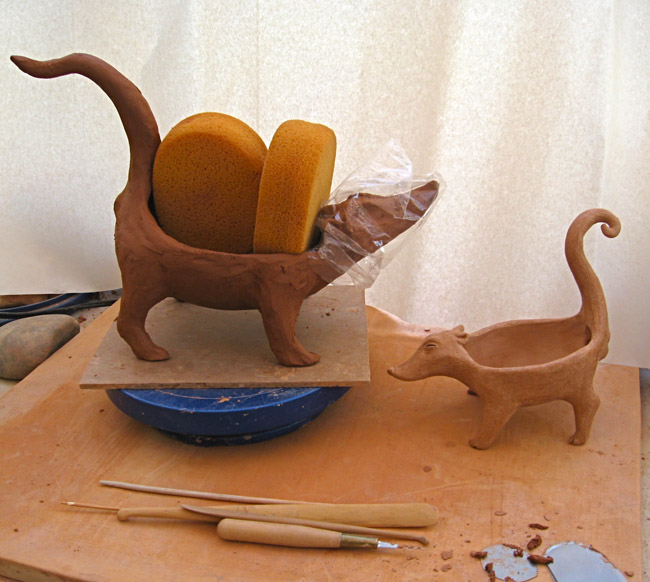
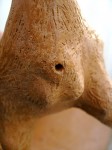
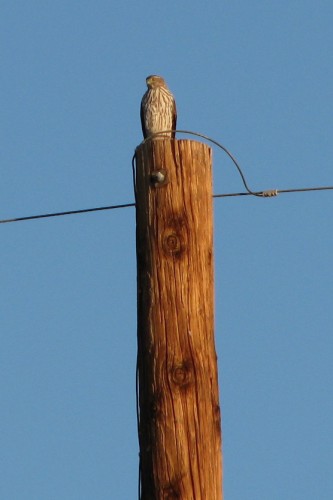
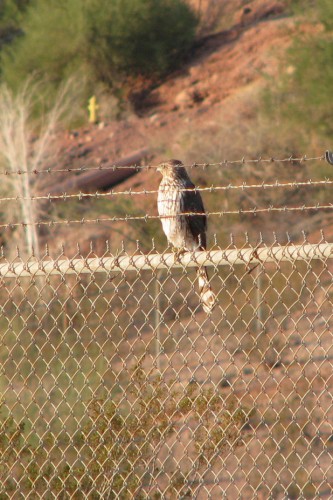
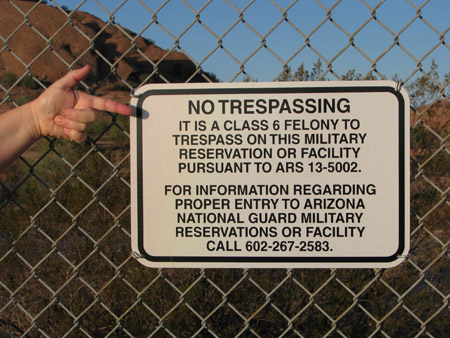
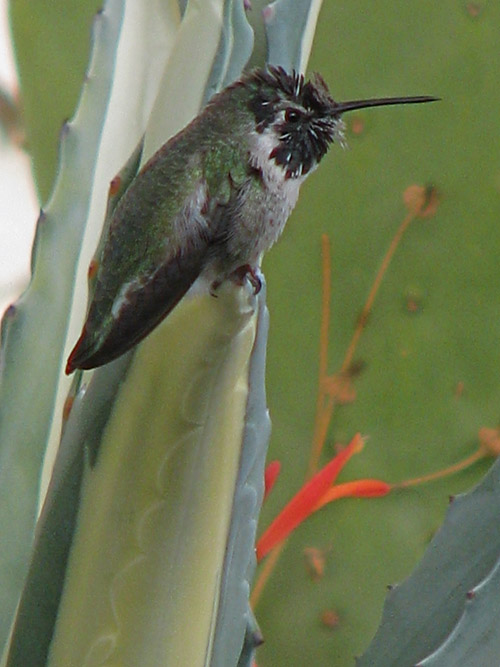
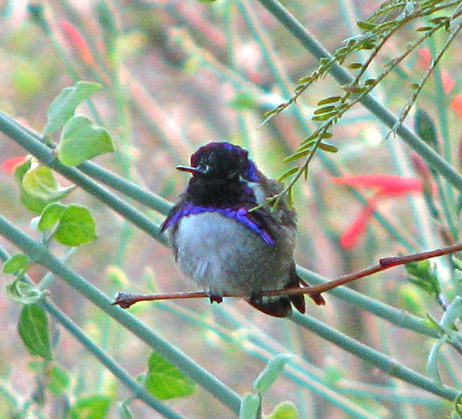
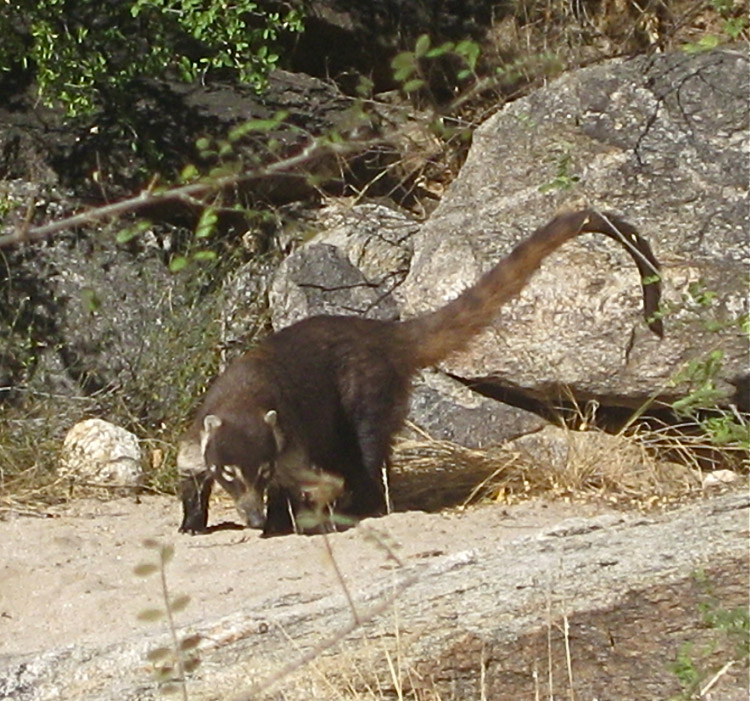
 Standing on line waiting for the millers to put your beans in the machine gives you ample time to shop around the Farmer’s Market or talk to other mesquite-bean collectors, and swap mesquite recipes and chat. We talked to Jean, who also had carob pods to grind. The process is not rapid — only a handful of pods goes in at a time, with the mill operators keeping a sharp eye out for rocks and debris, even though everyone’s pods are inspected once already, since hard objects in the steel blades would be hazardous and damaging.
Standing on line waiting for the millers to put your beans in the machine gives you ample time to shop around the Farmer’s Market or talk to other mesquite-bean collectors, and swap mesquite recipes and chat. We talked to Jean, who also had carob pods to grind. The process is not rapid — only a handful of pods goes in at a time, with the mill operators keeping a sharp eye out for rocks and debris, even though everyone’s pods are inspected once already, since hard objects in the steel blades would be hazardous and damaging. 